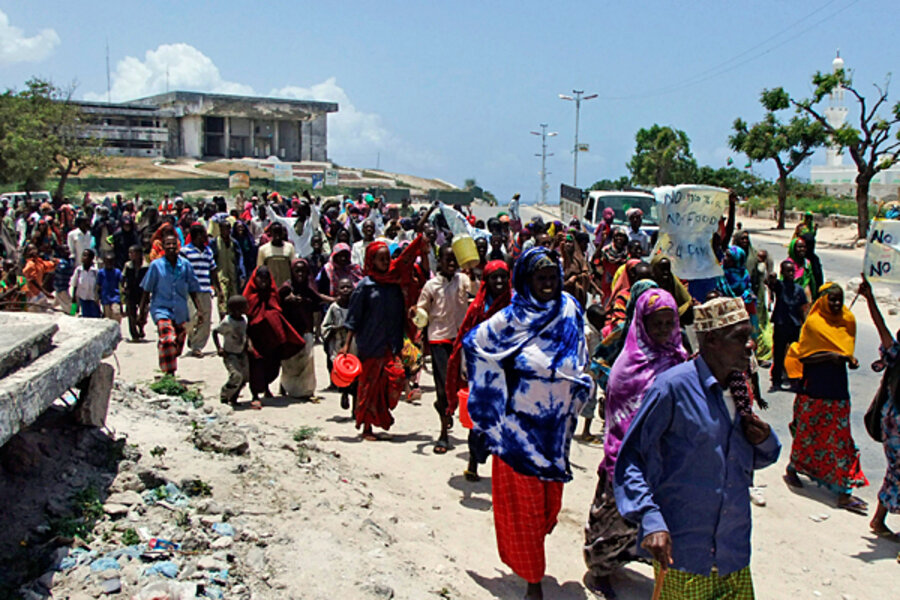Good Reads: Somalia's famine, India's sex selection, and Twitter wars
Loading...
There should be a prize for reporters who write engaging stories about issues that most of us would rather ignore.
For weeks now, the famine in the Horn of Africa region has been in the headlines, with estimates of how many people are at risk of starvation, how many regions of Somalia are affected, and how the ongoing civil war in that country – and the paranoid nature of one powerful militant group, Al Shabab, which bans foreign aid groups – have hampered efforts to distribute food aid to the starving.
It’s not an easy subject, and a great many of us prefer to dig into our pockets, give generously, and then studiously look away.
But Jeffrey Gettleman of The New York Times isn’t letting us off that easily. This week, he writes from Dolo, Somalia, that what we’ve seen thus far is just the first phase of this crisis. The second phase is when the rains come, increasing the chances of the spread of water-borne diseases among the greatly weakened people living in displacement camps. And all of this is happening precisely when the world’s rich countries are preoccupied with their own financial crises, and are therefore less willing or able to help out those less fortunate.
The result, as Mr. Gettleman writes is the possibility of “hundreds of thousands of deaths.”
“We’ve lost this round,” said Ken Menkhaus, a political science professor at Davidson College. “The numbers are going to be horrifying. We’re too late.”
As for those Somali warlords halting the aid convoys, they're about to get a few more guns. So reports Drew Hinshaw in a strong piece for the Monitor about how the collapse of the Qaddafi regime in Libya means that a flood of weapons and jobless migrants and mercenaries is already starting to flow into the arid Sahel region, which stretches from Senegal to Somalia.
India has been making headlines these days more for its economic progress – which company just became the world’s largest steel producer, which pharmaceutical company just purchased Windsor Castle, etc. – but Global Post this week reminds us that India’s amazing growth and development is still quite uneven, and despite having a strong constitution guaranteeing the rights of women, Indians still prefer having male children.
The result is sex-selection, an illegal but common practice where doctors help pregnant women and their husbands to identify the gender of a fetus, and abort that fetus if it is female. And because of sex selection, India now has the lowest female-to-male child ratios since independence in 1947.
A story like this has the power to horrify a reader, but Global Post writer Hanna Ingber Win works hard to empathize with the parents she meets, Anu and Sanjay, who have made the decision multiple times to illegally abort female fetuses. The pressure of tradition and the structure of traditional Indian families encourages sex-selection, and the availability of sophisticated technology allows middle class and rich Indian families to make choices individually that will have massive repercussions later for Indian society.
There have long been religious, social, and economic pressures on Indian families to have a son. Once daughters grow up, they will traditionally get married and go live with their in-laws. Sons, on the other hand, stay home and take care of the parents as they grow old.
Anu says she would have stopped having children after the first two daughters, but her husband and mother-in-law kept insisting the family needed a son. In many communities, Indian women who have a son are given more respect and status.
“Your security is your son,” Anu said as she sat upstairs from her physician’s clinic in Mohopada village, about 40 miles outside Mumbai.”
Finally, this week saw combat in the streets of Kabul, and conflict of a different sort between the International Security Assistance Force and Taliban spokesmen – the First Afghan Twitter War, or a Twar, if you prefer. One can imagine the furious typing of two very miffed and idealistic young individuals, cramming as much anger and invective into 140 characters as possible.
Oh sure, you can laugh about it. Twar is hell. The Guardian’s reporter Haroon Siddique wrote the original piece on the ISAF-Taliban twar, with great detail, and a wink at the silliness of it all.
But Foreign Policy’s Daniel Drezner had the most fun, delving into the culture of twitter wars, or as he calls it, Twitter Fight Club.
Drezner disagrees with those who say this phenomenon is as old as “cross-trench trash-talking” between soldiers in the Spanish Civil War. (Surely it goes back before that, as this Monty Python skit suggests.)
"This is something different, something that I suspect is activating Anne-Marie Slaughter's sixth sense of detecting 'modern social-liberal' trends. And as more and more international affairs heavyweights go on Twitter, it might be a harbinger of a whole new arena of the world politics sandbox," Drezner writes.





